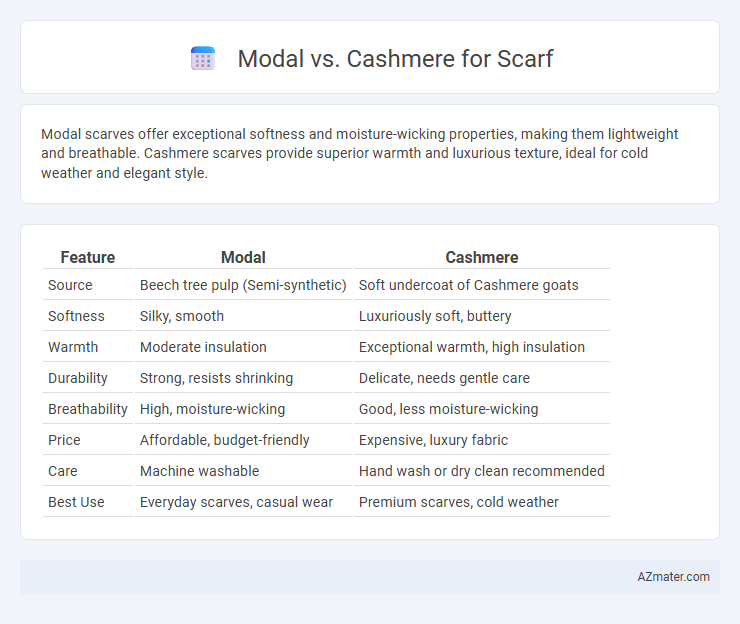Modal scarves offer exceptional softness and moisture-wicking properties, making them lightweight and breathable. Cashmere scarves provide superior warmth and luxurious texture, ideal for cold weather and elegant style.
Table of Comparison
| Feature | Modal | Cashmere |
|---|---|---|
| Source | Beech tree pulp (Semi-synthetic) | Soft undercoat of Cashmere goats |
| Softness | Silky, smooth | Luxuriously soft, buttery |
| Warmth | Moderate insulation | Exceptional warmth, high insulation |
| Durability | Strong, resists shrinking | Delicate, needs gentle care |
| Breathability | High, moisture-wicking | Good, less moisture-wicking |
| Price | Affordable, budget-friendly | Expensive, luxury fabric |
| Care | Machine washable | Hand wash or dry clean recommended |
| Best Use | Everyday scarves, casual wear | Premium scarves, cold weather |
Introduction: Modal vs Cashmere for Scarves
Modal scarves offer exceptional softness and breathability, making them ideal for lightweight, comfortable wear in various climates. Cashmere scarves provide luxurious warmth and a plush texture, crafted from fine goat fibers that insulate effectively in colder weather. Choosing between Modal and Cashmere depends on desired warmth, durability, and budget considerations, with Modal excelling in moisture-wicking properties, while Cashmere delivers premium thermal insulation.
Fiber Origins and Production
Modal fibers are derived from renewable beech tree pulp, processed through a semi-synthetic method that emphasizes sustainability and durability. Cashmere originates from the undercoat of Cashmere goats, harvested through delicate hand-combing techniques primarily in Mongolia, China, and Nepal. While Modal production relies on wood cellulose regeneration, Cashmere involves natural animal fiber collection, resulting in distinct textures and warmth properties for scarves.
Texture and Feel Comparison
Modal fabric offers a smooth, silky texture that feels lightweight and breathable, making it ideal for scarves that drape elegantly. Cashmere, derived from soft goat undercoat fibers, provides an ultra-luxurious, plush feel with exceptional warmth and softness against the skin. While Modal's texture is durable and moisture-wicking, Cashmere excels in delivering unmatched coziness and a delicate, sumptuous touch perfect for cold weather accessories.
Warmth and Insulation
Cashmere scarves provide exceptional warmth and superior insulation due to their fine, natural fibers that trap heat efficiently. Modal scarves, made from semi-synthetic fibers, offer moderate warmth but lack the insulating properties of cashmere. For cold climates, cashmere is the preferred choice for optimal heat retention and softness.
Durability and Longevity
Modal scarves exhibit superior durability due to their resistance to shrinking and pilling, maintaining softness over extended use. Cashmere, while luxuriously soft and warm, tends to be more delicate, requiring careful handling to prevent wear and tear. Choosing modal ensures longer-lasting wear with less maintenance, whereas cashmere offers premium softness but may not retain its pristine condition as long.
Breathability and Comfort
Modal scarves excel in breathability due to their semi-synthetic fibers derived from beech trees, allowing moisture to wick away and keeping the skin cool and dry. Cashmere scarves offer superior comfort with their natural softness and insulating properties, providing warmth without heaviness, making them ideal for colder climates. While Modal prioritizes moisture management and airflow, Cashmere focuses on luxurious softness and thermal insulation, catering to different comfort needs.
Eco-Friendliness and Sustainability
Modal scarves are made from beech tree pulp, a renewable resource processed in a closed-loop system that recycles water and solvents, making them highly eco-friendly. Cashmere production involves harvesting hair from cashmere goats, which can lead to overgrazing and land degradation if not managed sustainably, posing environmental concerns. Choosing modal scarves supports sustainable forestry practices and lower environmental impact, while sustainable cashmere requires certifications ensuring ethical animal treatment and land management.
Maintenance and Care Requirements
Modal scarves require gentle washing in cold water and air drying to maintain their softness and prevent shrinking, while cashmere scarves need delicate hand washing or dry cleaning to preserve their luxury texture and prevent pilling. Both fabrics benefit from storage in breathable garment bags to avoid moth damage and maintain fiber quality. Proper care extends the lifespan of modal and cashmere scarves, keeping them soft, durable, and visually appealing.
Price Point and Value
Modal scarves offer a budget-friendly price point while maintaining softness and durability, making them an accessible option for everyday wear. Cashmere scarves command a higher price due to the luxurious feel, superior warmth, and natural fiber quality, providing greater long-term value despite the initial investment. Choosing between modal and cashmere depends on prioritizing either affordability with decent comfort or premium warmth and elegance.
Best Uses and Style Recommendations
Modal scarves offer a lightweight, breathable option ideal for mild weather and casual wear, with excellent drape and vibrant color retention enhancing everyday outfits. Cashmere scarves provide superior warmth and softness, perfect for cold climates and formal occasions, adding a touch of luxury and sophistication to winter attire. Choosing between Modal and Cashmere depends on desired comfort level, occasion, and climate, balancing style with functional warmth.

Infographic: Modal vs Cashmere for Scarf
 azmater.com
azmater.com